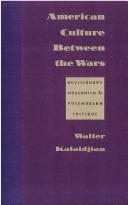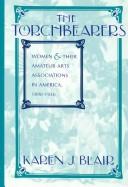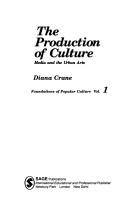| Listing 1 - 10 of 21 | << page >> |
Sort by
|
Digital
Year: 1803 Publisher: Providence Printed by J. Carter
Abstract | Keywords | Export | Availability | Bookmark
 Loading...
Loading...Choose an application
- Reference Manager
- EndNote
- RefWorks (Direct export to RefWorks)

ISBN: 0231082789 Year: 1993 Publisher: New York Columbia University Press
Abstract | Keywords | Export | Availability | Bookmark
 Loading...
Loading...Choose an application
- Reference Manager
- EndNote
- RefWorks (Direct export to RefWorks)
Book
ISBN: 0855201223 9780855201227 Year: 1976 Publisher: London: Robertson,
Abstract | Keywords | Export | Availability | Bookmark
 Loading...
Loading...Choose an application
- Reference Manager
- EndNote
- RefWorks (Direct export to RefWorks)
Arts --- Finance --- Arts - Great Britain - Finance --- Arts - United States - Finance

ISBN: 0313224978 Year: 1981 Publisher: Westport, Conn. ; London Greenwood Press
Abstract | Keywords | Export | Availability | Bookmark
 Loading...
Loading...Choose an application
- Reference Manager
- EndNote
- RefWorks (Direct export to RefWorks)
Book
ISBN: 082640653X Year: 1994 Publisher: New York (N.Y.) : Continuum,
Abstract | Keywords | Export | Availability | Bookmark
 Loading...
Loading...Choose an application
- Reference Manager
- EndNote
- RefWorks (Direct export to RefWorks)

ISBN: 0585220883 9780585220888 0253311926 Year: 1994 Publisher: Bloomington Indiana University Press
Abstract | Keywords | Export | Availability | Bookmark
 Loading...
Loading...Choose an application
- Reference Manager
- EndNote
- RefWorks (Direct export to RefWorks)
The arts clubs for women that flourished during the Progressive Era played a major role in the emergence of middle-brow culture in America. Although nineteenth-century women were expected to acquire knowledge of the arts sufficient for the amusement and edification of their families, they were nonetheless excluded from professional circles. For women seeking a more active role in cultural life, the voluntary arts associations were a vehicle by which they could expand into the public sphere their domestic support of the arts. The Torchbearers shows that these clubs were more than havens for artistic dilettantes. They were effective advocacy groups for promoting universal access to the fine arts, and they left a vital legacy of cultural programs and institutions. Clubwomen - typically white, urban, Protestant, and middle class - considered themselves "torchbearers" who could lead others to embrace the highest ideals. They combatted popular or vulgar culture while promoting women and regional artists ignored by the professional elite and encouraging creative expression for everyone. In the process, they helped build an audience for "high" culture, promoted municipal art galleries, started numerous little theaters, and made a place for the arts in the school curriculum. Even in the context of the growing professionalism in the arts and the benevolence of large, well-funded male philanthropic institutions, the women's amateur arts clubs were influential in the evolving cultural life of the nation.
Feminism and the arts --- Women --- Fine Arts - General --- Art, Architecture & Applied Arts --- Human females --- Wimmin --- Woman --- Womon --- Womyn --- Females --- Human beings --- Femininity --- Arts and feminism --- Arts --- History --- Societies and clubs. --- Societies and clubs --- United States --- 19th century --- 20th century --- Feminism and the arts - United States - History - 19th century. --- Feminism and the arts - United States - History - 20th century. --- Women - United States - Societies and clubs.

ISBN: 0803936931 Year: 1992 Volume: vol 1 Publisher: Newbury Park, Calif. london New Delhi Sage
Abstract | Keywords | Export | Availability | Bookmark
 Loading...
Loading...Choose an application
- Reference Manager
- EndNote
- RefWorks (Direct export to RefWorks)
Mass communications --- Art --- Sociology of culture --- United States --- Mass media and the arts --- Popular culture --- Europe --- Mass media and the arts - United States. --- United States - Popular culture. --- Mass media and the arts - Europe. --- Europe - Popular culture. --- United States of America
Book
ISBN: 9782707158703 2707158704 Year: 2010 Publisher: Paris: La Découverte,
Abstract | Keywords | Export | Availability | Bookmark
 Loading...
Loading...Choose an application
- Reference Manager
- EndNote
- RefWorks (Direct export to RefWorks)
Comment la culture aux États-Unis est-elle passée d'une réalité partagée par des publics socialement diversifiés à un univers clairement séparé des pratiques de divertissement et réservé à une élite ? Pour répondre à cette question, l'historien américain Lawrence W. Levine retrace la trajectoire, au tournant des XIXe et XXe siècles, des formes d'expression qui constituent aujourd'hui la culture «savante» : théâtre - en particulier shakespearien, sur lequel il s'attarde pour montrer à quel point le spectateur ordinaire s'était approprié le répertoire et se manifestait durant les spectacles... -, opéra, musique symphonique, musées. Levine enquête à la fois sur le langage employé pour évoquer et classer les biens culturels, sur les institutions mises en place par les élites urbaines pour imposer leurs normes et sur les pratiques des spectateurs et leurs résistances. Par un processus de «sacralisation» et de «bifurcation», la riche «culture publique partagée» qui caractérisait les États-Unis jusqu'au milieu du XIXe siècle se serait fracturée en cultures séparées et hiérarchisées. L'auteur analyse ainsi les rapports de pouvoir à l'oeuvre dans la définition, l'organisation et la réception de la culture. Il montre comment la notion même de culture s'est trouvée étroitement associée aux notions d'ordre et de hiérarchie, et comment les publics ont été «disciplinés». Devenu une référence outre-Atlantique, Culture d'en haut, culture d'en bas a renouvelé la compréhension de la réception des oeuvres, de la «légitimité culturelle», des politiques culturelles et de la place des publics dans les institutions.
Popular culture --- Arts --- Culture diffusion --- Social classes --- Culture populaire --- Diffusion culturelle --- Classes sociales --- United States --- History --- Sociologie de la culture --- États-Unis --- Vie intellectuelle --- Histoire --- Histoire. --- Popular culture - United States --- Arts - United States --- United States - Popular culture - History - 20th century

ISBN: 0822954656 Year: 1992 Publisher: Pittsburgh London University of Pittsburgh Press
Abstract | Keywords | Export | Availability | Bookmark
 Loading...
Loading...Choose an application
- Reference Manager
- EndNote
- RefWorks (Direct export to RefWorks)
Book
ISBN: 1282033328 9786612033322 0833046594 0833045776 9780833046598 9781282033320 9780833045775 6612033320 Year: 2008 Publisher: RAND Corporation
Abstract | Keywords | Export | Availability | Bookmark
 Loading...
Loading...Choose an application
- Reference Manager
- EndNote
- RefWorks (Direct export to RefWorks)
Projects what the future likely holds for state arts agencies and for state arts policy if current trends and current strategies for addressing economic, political, and demographic challenges continue.
Art commissions -- United States. --- Government aid to the arts -- United States. --- U.S. states -- Cultural policy. --- Government aid to the arts --- Art commissions --- U.S. states --- Fine Arts - General --- Art, Architecture & Applied Arts --- Cultural policy --- Cultural policy. --- Commissions, Art --- State arts agencies --- Arts --- Government patronage of the arts --- Government aid --- Art, Municipal --- Art and state --- Education and state --- Finance
| Listing 1 - 10 of 21 | << page >> |
Sort by
|

 Search
Search Feedback
Feedback About UniCat
About UniCat  Help
Help News
News